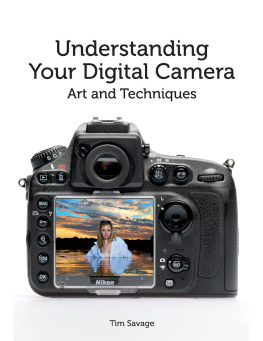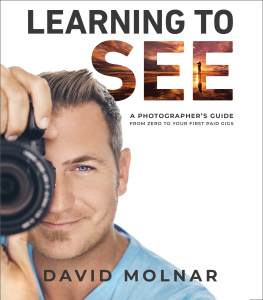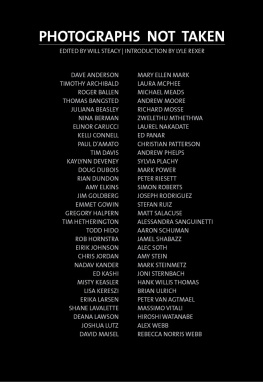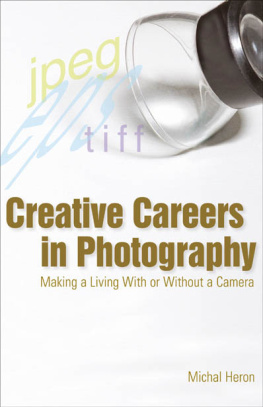THE VISUAL TOOLBOX
60 LESSONS FOR STRONGER PHOTOGRAPHS
DAVID DUCHEMIN
The Visual Toolbox: 60 Lessons for Stronger Photographs
David duChemin
New Riders
www.newriders.com
To report errors, please send a note to
New Riders is an imprint of Peachpit, a division of Pearson Education.
Copyright 2015 by David duChemin
All photography David duChemin except where noted
Acquisitions Editor: Ted Waitt
Project Editor: Valerie Witte
Senior Production Editor: Lisa Brazieal
Copyeditor: Liz Welch
Indexer: James Minkin
Compositor: Kim Scott/Bumpy Design
Cover and Interior Design: Charlene Charles-Will
Cover Image: David duChemin
Notice of Rights
All rights reserved. No part of this book may be reproduced or transmitted in any form by any means, electronic, mechanical, photocopying, recording, or otherwise, without the prior written permission of the publisher. For information on getting permission for reprints and excerpts, contact .
Notice of Liability
The information in this book is distributed on an As Is basis without warranty. While every precaution has been taken in the preparation of the book, neither the author nor Peachpit shall have any liability to any person or entity with respect to any loss or damage caused or alleged to be caused directly or indirectly by the instructions contained in this book or by the computer software and hardware products described in it.
Trademarks
Many of the designations used by manufacturers and sellers to distinguish their products are claimed as trademarks. Where those designations appear in this book, and Peachpit was aware of a trademark claim, the designations appear as requested by the owner of the trademark. All other product names and services identified throughout this book are used in editorial fashion only and for the benefit of such companies with no intention of infringement of the trademark. No such use, or the use of any trade name, is intended to convey endorsement or other affiliation with this book.
ISBN-13 978-0-134-08506-7
ISBN-10 0-134-08506-X
9 8 7 6 5 4 3 2 1
Printed and bound in the United States of America
To Cynthia Brooke.
Walk through this world with me.
Acknowledgments
After a number of books, the ability to say new things about the people for whom you are grateful begins to diminish. The gratitude, however, only grows. I am deeply thankful to the following people for their role in this book, in previous books, and in my life, because these books have played so strong a role in the direction my life has taken.
I hope you will forgive my brevity and know that theres an inverse relationship between the paucity of my words and the abundance of my gratitude. Ted Waitt, my partner in crime on this, our sixth book together. Nancy Aldrich-Ruenzel, my publisher. Mimi Heft, my designer, and Lisa Brazieal, my production editor. Thank you for another chance to make something beautiful and teach others the craft I so love.
Corwin Hiebert, my manager and best friend. I could not do this without you, and Im having way too much fun to want to if I could. Thank you. Cynthia Brooke Haynes, my partner in love and traveltogether we are writing a beautiful, unexpected story, and I cant wait to see where it leads next. I love you. To my mother, Heather, and my father, Dick, for giving me not only this life I so love, but for putting up with the plot twists, and hospital visits, that make you wonder occasionally if that life couldnt just be a little less uncertain. Thank you for believing in me, loving me, and giving me some pretty great genes.
And to you, my readers, friends, followers, and students, thank you for keeping me honest, for reading my words, leaving honest but enthusiastic reviews, commenting on my blog, interacting on social media, and, yes, buying my books. The life I get to live allows me to keep making these books, and making the photographs that you see in them, but it is you who makes possible those adventures, and I have never lost sight of that. From the bottom of my heart, thank you.
About the Author
Photo by Yves Perrault
David duChemin is a humanitarian and world photographer. He has photographed on all seven continents, looking for adventure and beauty along the way. He is the author of several books about the craft and art of photography, including the best-selling Within the Frame: The Journey of Photographic Vision. He is also the author and publisher of a growing library of eBooks, which can be found at CraftAndVision.com
Davids work can be found at DavidDuChemin.com, as can his blog and the growing community of kind and talented people who read it.
Contents
Introduction
If I were to begin a school of photography right now, it would send the geeks screaming for the hills. Or at least avoiding my school in droves. Every student would spend one year with one cameraa fully manual 35mm camera like the Pentax Spotmatic or the Canon AE-1. It would have one prime lens and a light meter. Students would be restricted to black and white film. And theyd be restricted from using anything digital except an iPhone. Thered be no magazines and no how-to books. Students would spend a year making photographs, talking about them, studying the work of photographerspast and presentwho had something to say, those who made their mark in some way. Theyd study stories, and painting, and some art history beyond merely the annals of photographic history. For some people it would be a long, long year.
Leica M (240), 21mm, 1/500 @ f/4, ISO 200
Fogo Island, Newfoundland, 2014.
A friend asked me recently if I felt photographic educators were these days too strongly biased toward the technical, that they did not pay enough attention to the aesthetic. I do. But it isnt just a problem today. It was the same almost 30 years ago when I first picked up a camera. And that was when there was little more to learn technically than how to focus and expose. Easily mastered with some time and a hundred rolls of film. I know, Im painting with a broad brush, but really, what more is there in terms of how the camera itself works? The rest is making a photograph that comes alive in some wayfor us, or for others.
So, because its not likely that anyone is signing up soon for my sadistic school of photographydespite the likelihood that grads would have a better chance at making more powerful images in less timethis is my short-form curriculum. It contains some compromises because I know my own brand of idealism doesnt appeal to all, nor does it work for all. Ive written it to be somewhat nonlinear, so you can pick any point and begin reading. But the lessons are all interconnected, so starting at the front isnt the worst idea. Ive also written it with what Scott Belsky, author of Making Ideas Happen, calls a strong bias towards action. In other words, we learn best by doing and theres a minimum of handholding in these pages. Ive given you as much as I feel you need to know in that beautiful brain of yours, the one none of us gives enough credit to. The rest you will learn, as you learn everything in lifeby repetition, failure, and trying again until it becomes yours.
You will notice here an absence of rules, because there are none. We will not be exploring the Rule of Thirds, because there is no such rule, and I want to encourage a healthy anarchy among my students. I want to introduce you to a handful of photographers who changed this art form and taught their generation, and later us, to see in new ways. I want to show you principles and invite you to play with them, turn them on their heads and try new things until you prove me wrong. I wont be marking your assignments, so theres no one to please and theres no exam to cram for only to regurgitate the contents the next day and forget about them. There is no right wayonly ways that will give you the tools you need to create new and beautiful, honest things with your camera.








